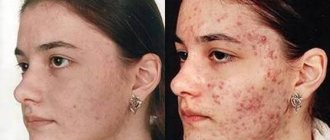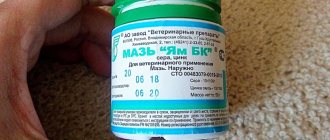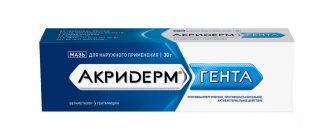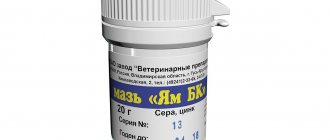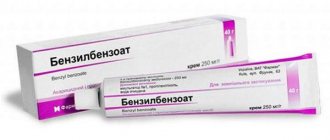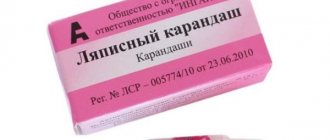Instructions for use BENZYLBENZOATE
Externally, locally (shake well before use). Children aged 3 to 5 years
the drug is diluted with boiled water in a ratio of 1:
- 1.
Treatment of pediculosis.
The drug is used externally, locally (the drug must be shaken before use). Moisten a cotton or gauze swab with the emulsion, apply to the scalp or body hair and lightly rub into the skin. Wrap your head in a scarf. After 10 minutes of treatment for pubic pediculosis and after 30 minutes for head lice, rinse off the drug with running water. When washing the drug off your head, avoid getting it on your face. After this, moisten the scarf with a warm 5% vinegar solution (mix a glass of vinegar with the same amount of water heated to 50°C) and, lightly wrung out the scarf, tie it around your head for 1 hour. At the same time, the nits peel off from the hair. After this procedure, the hair is washed with soap or shampoo, combed with a thick comb, and dead lice and nits are removed. The effectiveness of anti-pediculosis treatment is determined after 1 hour or after 1 day. If nits remain, the hair is treated again with only a 5% vinegar solution.
Treatment of scabies.
To prevent secondary invasion, simultaneous treatment of all family members living together, as well as contact persons, is necessary. Before using the emulsion, you must take a shower. The emulsion is applied (can be done with a brush) to the entire body, with the exception of the face and scalp. Apply especially carefully to the wrists, bones, armpits, thighs, groin area, under the nails, areas between the fingers and toes, and the soles of the feet. Allow the emulsion to dry (usually 10 minutes in a warm room). After the emulsion has dried, put on clean underwear and change the bed linen. Hands should not be washed for 3 hours after treatment.
With careful application of the emulsion, one application of the skin is usually sufficient. Repeated treatment over the next 5 days reduces the likelihood of residual infestation.
An alternative method of treatment is to apply the emulsion to the entire body, with the exception of the face and scalp, 3 times with an interval of 12 hours. 42 hours after the last application of the drug, you must take a hot shower, change your underwear and bed linen.
Treatment of demodicosis.
The drug is used in the evening. In the evening, wash your face with warm water and soap, then apply the drug in a thin layer to your facial skin. In this case, it is necessary to avoid getting the drug into the eyes, nose and mouth. In the morning, wash your face with warm water and soap. The duration of the course of treatment is determined by the dynamics of skin cleansing, relief of the inflammatory process, cessation of itching and usually lasts 2-3 weeks.
When the emulsion thickens, you need to carefully warm the bottle or container in a container with warm water (not higher than 40°C).
Benzyl benzoate
Benzyl benzoate is an external medicine (emulsion, ointment) intended for the treatment of scabies. Causes toxic damage to scabies mites. Has an anti-pediculosis effect. Used in pediatric practice in patients over three years of age. Contraindicated for persons with individual intolerance to the active component, pregnant women and nursing mothers. The duration of treatment, regardless of the dosage form, is 4 days. For adults, 20% ointment (or emulsion) is indicated, for children - 10%. Before use, the emulsion is diluted with boiled water at room temperature, using equal parts of water and the drug. On the first day, apply the emulsion or ointment in the evening before going to bed after taking a warm shower and thoroughly washing with soap. The pharmaceutical substance (whether it is an emulsion or an ointment) is rubbed into the skin of the upper extremities, torso, and then the lower extremities. After the procedure, only clean underwear and wardrobe items are used. For the next two days, benzyl benzoate is not applied, and the remnants of the previously applied substance are washed off with water. The fourth day repeats the first day: the patient takes a shower, performs all hygienic measures, rubs the drug into the skin in a given sequence and changes clothes. After completing the procedure, you should refrain from washing your hands for three hours. In the future, apply the drug to your hands after each wash.
The same is done for other areas of the skin from which the emulsion or ointment was accidentally washed off. The drug is completely removed from the skin of the body on the fifth day. Drug therapy for complications caused by scabies (inflammatory, purulent and/or eczematous skin lesions) is carried out simultaneously with treatment of the underlying disease until the patient is completely cured of all its consequences. Benzyl benzoate is well tolerated by patients. Side effects are relatively rare. In this regard, only allergic and local reactions can be noted, manifested by irritation, hyperemia and local burning. If such reactions of the body to benzyl benzoate develop, its use should be discontinued. There are no cases of drug overdose or pharmacological interaction with other drugs reported in the medical literature. Itchy skin at the end of treatment does not indicate its failure and the need for a second course of medication: this is the body’s reaction to a dead tick. It resolves with the use of antihistamines and external glucocorticosteroids. All items with which the patient has been in contact must be subjected to heat treatment. The apartment must be thoroughly cleaned using detergents and disinfectants.
Interaction with other drugs
No pharmacological interaction of Benzyl benzoate ointment with other drugs has been identified, however, like all antiparasitic agents, it is not recommended to be used simultaneously with other external medications. Local or systemic use of corticosteroids may help to eliminate or reduce the manifestation of some symptoms (itching, hyperemia, etc.) while the invasion persists, so the use of such drugs should be avoided during treatment with Benzyl benzoate ointment.
Cetylpyridinium chloride, which is part of the drug as an antimicrobial preservative and emulsifier, interacts with anionic surfactants, in particular with soaps. This can lead to loss of the bacteriostatic properties of the drug and its coagulation.
Symptoms of demodicosis
Demodicosis manifests itself in 2 forms: the skin form of the disease and demodicosis of the eyelids .
With the cutaneous form of demodicosis, inflammation appears on the skin of the face, the chin, cheeks and brow ridges are especially affected. The skin of the chest and back is much less commonly affected. The main symptom of the cutaneous form of demodicosis is inflammation of the sebaceous glands and hair follicles, which leads to the formation of acne, redness of the skin and the formation of crusts.
Symptoms of demodicosis of the eyes may be as follows:
- itching and burning at the base of the eyelashes;
- eyelashes sticking together in the morning;
- rapid eye fatigue;
- dry eye syndrome;
- yellowish mucus in the eyes;
- sensation of a foreign body in the eye.
Symptoms may worsen in the morning, as well as after taking a hot bath, visiting a bathhouse or sauna, or being in the sun.
If such symptoms are detected, you should urgently consult a dermatologist (in the case of the skin form of the disease) or an ophthalmologist (in the case of eye demodicosis): the disease is contagious and quickly spreads to neighboring areas.
1 Diagnosis and treatment of demodicosis
2 Diagnosis and treatment of demodicosis
3 Treatment of demodicosis
What is the diagnosis of eye demodicosis based on?
An experienced ophthalmologist conducts special laboratory tests to identify Demodex mites, and also pays attention to the visible characteristic signs of eye demodicosis:
- redness along the edges of the eyelids;
- pustules between eyelashes;
- sticky eyelashes with a yellowish coating and scales;
- dilated capillaries of the eyelids and retina;
- thinning and frequent loss of eyelashes.
Side effect
When applying benzyl benzoate ointment topically, no adverse reactions are usually observed. However, when applying the drug, a burning sensation may occur, which goes away with further use of the ointment. In rare cases, people with sensitive skin may experience local skin reactions (burning or itching, redness or dryness of the skin area treated with the drug), as well as allergic skin reactions. If the above side effects do not go away on their own, the use of the drug must be discontinued.
Benzyl benzoate 20% 200ml emulsion for external use
pharmachologic effect
Anti-scabies.
Composition and release form Benzyl benzoate 20% 200ml emulsion for external use
Emulsion - 1 g:
- active ingredients: benzyl benzoate - 200 mg;
- excipients: laundry soap 72%; emulsion wax; purified water - up to 1 g
In bottles or bottles of 50, 100 and 200 g; in a cardboard pack 1 bottle or bottle.
Description of the dosage form
A homogeneous white emulsion with a slight specific odor.
Directions for use and doses
Externally. For scabies, adults are prescribed a 20% emulsion, children under 5 years old - 10%. On the 1st day, treatment is carried out in the evening before bed after washing thoroughly in the shower with warm water and soap. The emulsion is rubbed into the skin of the hands, then the torso and legs, including the soles and fingers. After treating the skin, only clean linen and clothing should be used. On the 2nd and 3rd days, take a break from treatment without washing off the remaining emulsion from the skin. On the 4th day of treatment, repeat the procedure of the first day and change the underwear again. Hands after treatment should not be washed for 3 hours; subsequently, hands are treated with an emulsion after each wash. If the emulsion is washed off from other parts of the body, their treatment must be repeated. On the 5th day of treatment, the drug is washed off. Treatment of complications of scabies (dermatitis, eczema, pyoderma, postscabiosis lymphoplasia) is carried out simultaneously with the treatment of scabies and continues after its completion.
Pharmacodynamics
Anti-scabies. Destruction of scabies mites.
Indications for use Benzyl benzoate 20% 200ml emulsion for external use
Scabies.
Contraindications
Pregnancy, breastfeeding, children (up to 3 years).
Application of Benzyl benzoate 20% 200ml emulsion for external use during pregnancy and lactation
Contraindicated. Breastfeeding should be stopped during treatment.
special instructions
Treatment of patients identified in one outbreak, as well as contact persons, must be carried out simultaneously to avoid re-infection.
The presence of itching after treatment is the body’s reaction to the waste products of the tick and is eliminated by prescribing antihistamines and ointments with glucocorticosteroids.
Do not allow the drug to come into contact with the eyes or mucous membranes of the nose and mouth. If the drug gets into your mouth: rinse with plenty of water or a 2% warm solution of baking soda; into the stomach - rinse with a 1–2% solution of baking soda, an aqueous mixture of burnt magnesia and activated carbon; into the eyes - rinse thoroughly with water or baking soda solution.
If signs of skin irritation appear, use of the drug should be discontinued.
Shake before use.
All items that have come into contact with infected skin are thoroughly treated: bedding and towels are boiled in a solution of washing powder for 5–10 minutes. Outerwear is ironed on both sides; items that are not subject to heat treatment are hung out in the open air for 3 days. Shoes and toys are excluded from circulation and placed in a plastic bag. Mattresses, pillows, blankets are excluded from use for 5 days or are subjected to chamber disinfection. Upholstered furniture is treated with disinsection preparations. The apartment is wet cleaned using disinfectants.
Side effects Benzyl benzoate 20% 200ml emulsion for external use
Skin irritation, burning sensation (especially in children).
Treatment of demodicosis of the eyes
It should be kept in mind that demodicosis of the eyes is caused by parasites, and the disease will not go away on its own. It must be treated over a long period. If you do not follow all the doctor’s instructions, demodicosis quickly becomes chronic, which is more difficult to treat. The insidiousness of the disease is that after some time the external signs of the disease disappear, but repeated self-infection may occur.
Therefore, treatment of demodicosis is quite long and includes a number of measures, including the following:
- compliance with personal hygiene rules, disinfection of bed linen;
- treating the eyelids with special products, cleaning the skin from crusts and plaque;
- treating the base of the eyelashes with drops or bactericidal gel;
- regular application of medicinal ointment prescribed by a doctor to the eyelids;
- regular massage of the eyelids and removal of discharge along with mites;
- the use of physiotherapeutic methods - magnetic therapy, electrophoresis, etc.;
- following a diet excluding sweets, spicy and salty foods;
- increasing immunity, eliminating foci of chronic infection.
